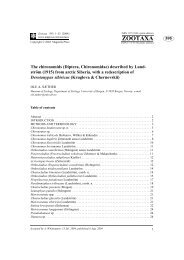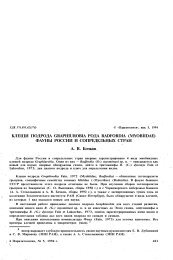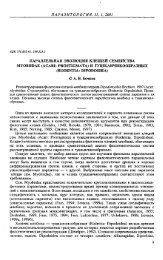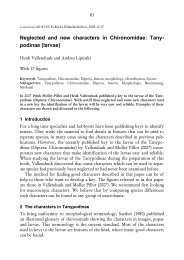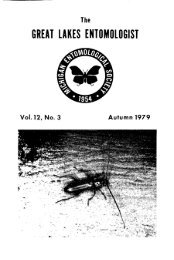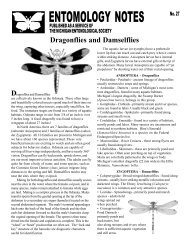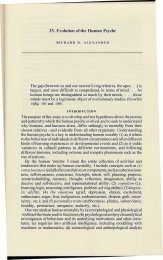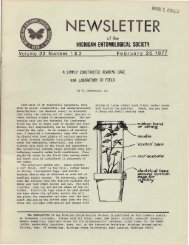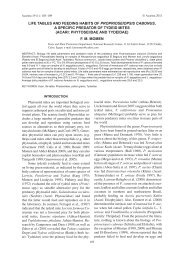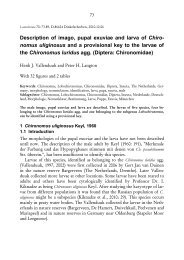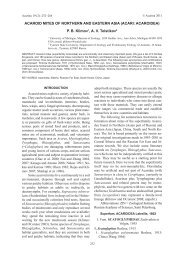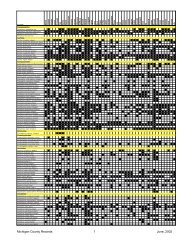Chironomus newsletter on Chironomidae research 22
Chironomus newsletter on Chironomidae research 22
Chironomus newsletter on Chironomidae research 22
Create successful ePaper yourself
Turn your PDF publications into a flip-book with our unique Google optimized e-Paper software.
PALEOLIMNOLOGICAL EVIDENCE CONFIRMS THAT PAROCHLUS STEINENII (GERKE) IS<br />
NOT A RECENT INTRODUCTION TO THE ANTARCTIC PENINSULA REGION<br />
Janelle T. Agius 1 , John A.E. Gibs<strong>on</strong> 1,2* , Eugenio Rico 3 and Ant<strong>on</strong>io Quesada 4<br />
1 Institute for Antarctic and Southern Ocean Studies, University of Tasmania, Private Bag 77, Hobart,<br />
Tasmania, Australia. Email: John.Gibs<strong>on</strong>@utas.edu.au<br />
2 Marine Research Laboratories, Tasmanian Aquaculture and Fisheries Institute, University of Tasmania,<br />
Private Bag 49, Hobart, Tasmania, Australia<br />
3 Departmento de Ecología, Universidad Autónoma de Madrid, 28049 Madrid, Spain<br />
4 Departmento de Biologia, Universidad Autónoma de Madrid, 28049 Madrid, Spain<br />
* Corresp<strong>on</strong>ding author<br />
Introducti<strong>on</strong><br />
Chir<strong>on</strong>omid remains are comm<strong>on</strong> in lake<br />
sediments, and have been used widely as<br />
indicators of change in climatic c<strong>on</strong>diti<strong>on</strong>s. Far<br />
fewer studies, however, have made use of the<br />
palaeobiogeographical potential of these remains<br />
to investigate past species distributi<strong>on</strong>s and the<br />
origins of isolated faunas.<br />
Two models have been suggested for the origin of<br />
Antarctic populati<strong>on</strong>s of the chir<strong>on</strong>omid<br />
Parochlus steinenii (Gerke) (Allegrucci et al.<br />
2005). It was originally suggested that this<br />
species could have been introduced to the<br />
Antarctic Peninsula regi<strong>on</strong> from farther north by<br />
human activities, beginning with whaling in the<br />
mid-to-late 1800s (C<strong>on</strong>vey and Block 1996). This<br />
suggesti<strong>on</strong> was predicated <strong>on</strong> the quite recent<br />
initial observati<strong>on</strong> (1950s) of this species in the<br />
South Shetland Islands and the Antarctic<br />
Peninsula (Torres 1956).<br />
Molecular studies indicated a different story.<br />
Analysis of 28S ribosomal RNA from three<br />
distinct populati<strong>on</strong>s of Parochlus steinenii<br />
suggested that the populati<strong>on</strong>s <strong>on</strong> the Antarctic<br />
Peninsula and the nearby South Shetland Islands<br />
had been separated from the other populati<strong>on</strong>s <strong>on</strong><br />
a time scale of milli<strong>on</strong> of years, and that each<br />
populati<strong>on</strong> was limited to particular tect<strong>on</strong>ic<br />
plates (Allegrucci et al. 2005).<br />
In this short note we use palaeolimnological<br />
techniques to test these models, and c<strong>on</strong>clude an<br />
ancient origin for the Antarctic Peninsula/South<br />
Shetland Island populati<strong>on</strong> of Parochlus steinenii.<br />
18<br />
Methods<br />
The study site was a small lake <strong>on</strong> Byers<br />
Peninsula, Livingst<strong>on</strong> Island (62°40’S, 61°00’W,<br />
Figure 1), that has been the centre of a c<strong>on</strong>certed<br />
scientific study (Toro et al. 2007), and which has<br />
become known as Limnopolar Lake. See<br />
www.aslo.org/photopost/showphoto.php/photo/70<br />
6/ppuser/158 for a picture of the lake. Livingst<strong>on</strong><br />
Island is in an active volcanic area, with nearby<br />
Decepti<strong>on</strong> Island having erupted as recently as<br />
1969 (Pallàs et al. 2001).<br />
During the Antarctic field seas<strong>on</strong> of 2002/2003 a<br />
29.2 cm sediment core was obtained from<br />
Limnopolar Lake using a modified hybrid Glew<br />
corer and Kajak corer. The core did not reach<br />
bedrock. The core was secti<strong>on</strong>ed <strong>on</strong> site into 0.2<br />
cm secti<strong>on</strong>s (0-10 cm), 0.5 cm secti<strong>on</strong>s (10-25<br />
cm), or 1.0 cm secti<strong>on</strong>s (25-29 cm). The secti<strong>on</strong>s<br />
were then transferred into labelled whirlpak bags,<br />
and stored at 4°C until analysed.<br />
Animal remains were isolated by placing<br />
approximately 1 g of wet sediment in a 20 ml<br />
scintillati<strong>on</strong> vial and adding distilled water to<br />
disperse the sediment. The sediment was sieved<br />
<strong>on</strong> 44 µm and 100 µm mesh, and the material<br />
retained <strong>on</strong> the sieves was treated with Rose<br />
Bengal to stain biological comp<strong>on</strong>ents. The<br />
material was examined under a dissecting<br />
microscope and chir<strong>on</strong>omid remains isolated for<br />
further study.<br />
Radiocarb<strong>on</strong> dating of the sediments, estimati<strong>on</strong><br />
of the relative abundance of aquatic moss (<strong>on</strong> an<br />
arbitrary scale), and measurement of abundance<br />
of tephra (microscopic shards of volcanic glass)<br />
were undertaken as described elsewhere (Agius<br />
2006).



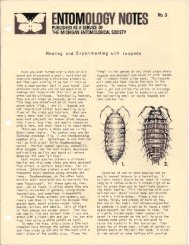
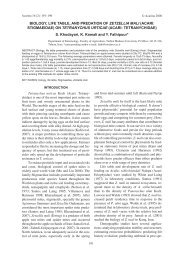
![Williamsonia 1-1 [v4.0] (DR) - Insect Division - University of Michigan](https://img.yumpu.com/18248489/1/190x245/williamsonia-1-1-v40-dr-insect-division-university-of-michigan.jpg?quality=85)
